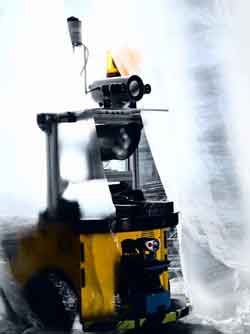Robot reconnoiters uncharted terrain

Equipped with multiple sensors and optical cameras, the mobile robot roams over dangerous ground. © Fraunhofer IOSB<br>
Industrial robots have been a familiar sight in the workplace for many years. In automotive and household appliance manufacture, for example, they have proved highly reliable on production and assembly lines.
But now a new generation of high-tech helpers is at hand: Mobile robots are being used in place of humans to explore hazardous and difficult-to-access environments such as buildings in danger of collapsing, caves, or ground that has been polluted by an industrial accident.
Equipped with sensors and optical cameras, these robots can help rescue services search for victims in the wake of natural disasters, explosions or fires, and can measure concentrations of hazardous substances. There’s just one problem: Often there is no map to show them the location of obstacles and steer them along navigable routes. Yet such maps are critical to ensuring that the high-tech machines are able to make progress, either independently or guided by remote control. Researchers at the Fraunhofer Institute for Optronics, System Technologies and Image Exploitation IOSB in Karlsruhe have now developed a roaming land robot that autonomously reconnoiters and maps uncharted terrain. The robot uses special algorithms and multi-sensor data to carve a path through unknown territory.
“To be able to navigate independently, our mobile robot has to fulfill a number of requirements. It must be able to localize itself within its immediate surroundings, continuously recalculate its position as it makes its way through the danger area, and simultaneously refine the map it is generating,” says graduate engineer Christian Frey of the IOSB. To make this possible, he and his team have developed an algorithm toolbox for the robot that runs on a built-in computer. The robot is additionally equipped with a variety of sensors. Odometry sensors measure wheel revolutions, inertial sensors compute accelerations, and distance-measuring sensors register clearance from walls, steps, trees and bushes, to name but a few potential obstacles. Cameras and laser scanners record the environment and assist in the mapping process. The algorithms read the various data supplied by the sensors and use them to determine the robot’s precise location. The interplay of all these different elements concurrently produces a map, which is updated continuously. Experts call the process Simultaneous Localization and Mapping, or SLAM.
Mobile robots face an additional challenge: to find the optimal path that will enable them to complete each individual task. Depending on the situation, this may be the shortest and quickest route, or perhaps the most energy-efficient, i.e. the one that uses the least amount of gasoline. When planning a course, the high-tech helpers must take into account restrictions on mobility such as a limited turning circle, and must navigate around obstacles. And should the environment change, for example as a result of falling objects or earthquake aftershocks, a robot must register this and use its toolbox to recalculate its route.
“We made our toolbox modular, so it’s not difficult to adapt the algorithms to suit different types of mobile robot or specific in- or outdoor application scenarios. For example, it doesn’t matter what sensor set-up is used, or whether the robot has two- or four-wheel drive,” says Frey. The software can be customized to meet the needs of individual users, with development work taking just a few months. Frey adds: “The toolbox is suitable for all sorts of situations, not only accident response scenarios. It can be installed in cleaning robots or lawnmowers, for example, and a further possible application would be in roaming robots used to patrol buildings or inspect gas pipelines for weak points.” From March 6-10, the IOSB researchers will be demonstrating their mobile robot technology at the CeBIT trade fair – visit them at the joint Fraunhofer booth in Hall 9 (Booth E08).
Media Contact
All latest news from the category: Power and Electrical Engineering
This topic covers issues related to energy generation, conversion, transportation and consumption and how the industry is addressing the challenge of energy efficiency in general.
innovations-report provides in-depth and informative reports and articles on subjects ranging from wind energy, fuel cell technology, solar energy, geothermal energy, petroleum, gas, nuclear engineering, alternative energy and energy efficiency to fusion, hydrogen and superconductor technologies.
Newest articles

NASA: Mystery of life’s handedness deepens
The mystery of why life uses molecules with specific orientations has deepened with a NASA-funded discovery that RNA — a key molecule thought to have potentially held the instructions for…

What are the effects of historic lithium mining on water quality?
Study reveals low levels of common contaminants but high levels of other elements in waters associated with an abandoned lithium mine. Lithium ore and mining waste from a historic lithium…

Quantum-inspired design boosts efficiency of heat-to-electricity conversion
Rice engineers take unconventional route to improving thermophotovoltaic systems. Researchers at Rice University have found a new way to improve a key element of thermophotovoltaic (TPV) systems, which convert heat…



